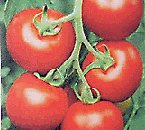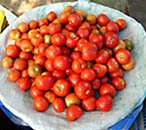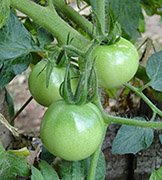Tomato Nutrition facts
Tomato is a juicy, nutritious fruit commonly eaten as a vegetable, and is another wonderful gift of the Mayans to the world. This humble vegetable of Central America has seized the attention of millions of health seekers for its incredible nutritional properties. Interestingly, it has more health-benefiting compounds than that of some popular fruits like apple!
Botanically, tomato belongs to Solanaceae or nightshade family of common vegetables, which also includes chili peppers,potato, eggplant, etc. Its scientific name is Lycopersicon esculentum.
 |
 |
| Tomatoes- Red skin variety. | Fresh produce in a market. |
This exotic vegetable of all seasons is native to Central America and was cultivated by the Aztecs centuries before the Spanish explorers introduced it to the rest of the world.
Many hundreds of cultivar varieties with different types and sizes, either organic, hybrid or genetically modified are being in use. Most cultivars produce red fruits; however, some cultivars with yellow, orange, pink, purple, green, or white colors are also a common scene.
 |
| Tomatoes- Raw, green. |
Heirloom tomatoes tend to produce more natural and flavorful fruits. Heirloom cultivars are becoming increasingly popular, particularly among organic vegetable consumers. They are now grown worldwide at a larger scale as one of the frontline vegetables, in line with onions, chili, potato..etc.
Cherry tomatoes (Solanum lycopersicum var. cerasiforme) are small, round, cherry-sized fruits of the same Solanaceae family. They are quite popular in the Mediterranean regions, featuring commonly in Italian and Greek cuisine.
Health benefits of Tomato
Tomatoes are one of the low-calorie vegetables; hold just 18 calories per 100 g. Very low in fats and zero cholesterol levels. Nonetheless, they are excellent sources of antioxidants, dietary fiber, minerals, and vitamins. On account of their all-around qualities, dieticians and nutritionists often recommend them in cholesterol controlling and weight-reduction diet programs.
The antioxidants in tomatoes are scientifically proven to be protective against cancers like colon, prostate, breast, endometrial, lung, and pancreatic tumors.
Total -ORAC (Oxygen Radical Absorbance Capacity) in this tomato is 367 µmol TE/100 g.
Lycopene, a flavonoid antioxidant, is a unique phytochemical compound found plentiful in tomatoes. Ripe, red tomatoes tend to carry more of this antioxidant. Together with carotenoids, lycopene may help protect cells and organs in humans against harmful oxygen-free radicals.
Studies suggest that lycopene protects the skin from ultra-violet (UV) rays and thus offers some defense against skin cancer.
Zea-xanthin is another flavonoid compound present abundantly in this vegetable. Zeaxanthin helps protect eyes from "age-related macular related macular disease" (ARMD) in older adults by filtering harmful ultraviolet rays.
Tomato contains excellent levels of vitamin-A and flavonoid antioxidants such as α and ß-carotenes, xanthins, and lutein. Altogether, these pigment chemicals are found to carry functions like night-vision, maintenance of healthy mucosa and skin, and bones. Consumption of flavonoid-rich, natural vegetables, and fruits are known to protect against lung and oral cavity cancers.
Additionally, they are also a good source of antioxidant vitamin-C (provide 21% of recommended daily levels per 100 g); consumption of foods rich in vitamin-C helps the body develop resistance against infectious agents and scavenge harmful free radicals.
Fresh tomato is very rich in potassium. 100 g contains 237 mg of potassium and just 5 mg of sodium. Potassium is an important component of cell and body fluids that helps regulate heart rate and blood pressure caused by sodium.
Further, they carry average levels of vital B-complex vitamins such as folates, thiamin, niacin, and riboflavin as well as some essential minerals like iron, calcium, manganese, and other trace elements.
| Principle | Nutrient Value | Percent of RDA |
|---|---|---|
| Energy | 16 Kcal | 1% |
| Carbohydrates | 3.9 g | 3% |
| Protein | 0.9 g | 1.6% |
| Total Fat | 0.2 g | 0.7% |
| Cholesterol | 0 mg | 0% |
| Dietary Fiber | 1.2 g | 3% |
| Vitamins | ||
| Folates | 15 µg | 4% |
| Niacin | 0.594 mg | 4% |
| Pyridoxine | 0.080 mg | 6% |
| Thiamin | 0.037 mg | 3% |
| Vitamin A | 833 IU | 28% |
| Vitamin C | 13 mg | 21.5% |
| Vitamin E | 0.54 mg | 4% |
| Vitamin K | 7.9 µg | 6.5% |
| Electrolytes | ||
| Sodium | 5 mg | >1% |
| Potassium | 237 mg | 5% |
| Minerals | ||
| Calcium | 10 mg | 1% |
| Iron | 0.3 mg | 4% |
| Magnesium | 11 mg | 3% |
| Manganese | 0.15 mg | 6.5% |
| Phosphorus | 24 mg | 3% |
| Zinc | 0.17 mg | 1.5% |
| Phyto-nutrients | ||
| Carotene-ß | 449 µg | -- |
| Carotene-a | 101 µg | -- |
| Lutein-zeaxanthin | 123 µg | -- |
| Lycopene | 2573 µg | -- |
Selection and storage
Fresh ripe tomatoes feature a beautiful bright red color and a rich fruity flavor. In the markets, buy fresh, firm, and uniform-sized fruits. Avoid those with wrinkled surfaces, discolored spots, cuts, and too soft and mushy.
Firm, yellow fruits can be placed in a cool, dark place at room temperature for 2-3 days. However, ripe tomatoes are one of the easily perishable vegetables and should be stored in the refrigerator. Use them while they are fresh to obtain the full benefits of natural vitamins and antioxidants.
Preparation and serving methods
Pests are common in tomatoes. Hybrid varieties are usually subjected to insecticide sprays. Therefore, wash them thoroughly in cold running water in order to remove dirt, soil, and any insecticide/fungicide residues.
To prepare, discard the stem and top calyx end. Cut into desired halves, cubes, slices, etc. Peel the skin and puree its juicy pulp. Some prefer to discard seeds before adding them to cooking.
 |
| Tomato-onion cheese tart topped with basil. Photo courtesy: Jennifer |
Here are some serving tips:
Tomatoes are employed generously in the cooking, especially in Mediterranean, Greek, Italian, Southeast Asian, and East European cuisines.
Raw ones have an extra acidic taste, but when mixed with other ingredients while cooking, they impart a wonderful flavor and rich taste.
All kinds of tomatoes, including cherry, are one of the commonly featured ingredients in salad preparations worldwide.
Fresh tomato juice and soup are popular healthy dishes served as an appetizer. Organic varieties hold three times more lycopene than non-organic fruits.
Delicious Spanish cold tomato and cucumber soup, gazpacho, is a popular Andalusian preparation.
Unripe, green tomatoes can be used in similar ways like other raw vegetables to prepare in curries, and stews and to make "chutney" in some of the Indian states.
Safety profile
In general, allergic reactions to tomatoes are relatively rare. However, it may sometimes occur in sensitive individuals with symptoms like itching skin and eyes, runny nose, and gastrointestinal disturbances like stomach pain, vomiting, and diarrhea. (Medical Disclaimer).
≺≺ Also read- Cherry tomatoes nutrition facts and health benefits.
≺≺ Back to Vegetables from Tomato. Visit here for an impressive list of vegetables with complete illustrations of their nutrition facts and health benefits.
≺≺ Back to Home page.
Further reading:
Department of Horticulture- Purdue University Cooperative extension service. (Link opens in new window).